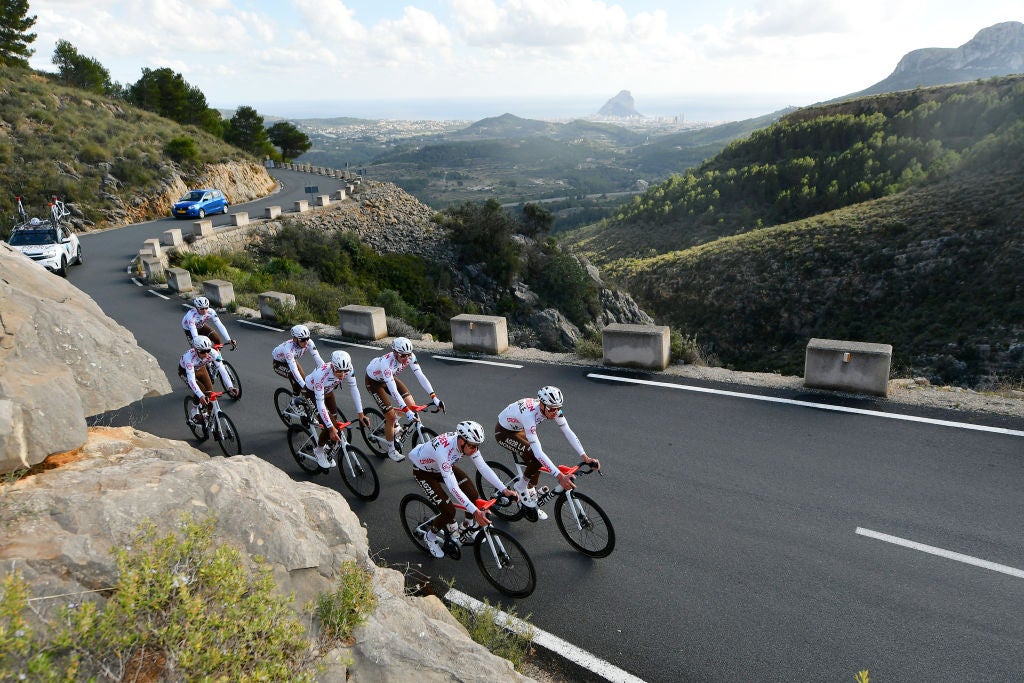
Artikel
04
januari
Winter’s Hotspot: Why the World’s Best Pro Cyclists Flock to Spain
CALPE, Spain (Velo) — Want to catch a glimpse of Tadej Poga?ar or Demi Vollering?
Don’t wait for the Tour de France in July.
Instead, make tracks this winter for Spain’s Costa Blanca, and you’ll likely see half the men’s and women’s peloton tracing the narrow, winding roads along the sparkling Mediterranean Coast in pre-season training camps.
Each winter, the best pro cyclists in the world clog the roads between Denia and Alicante in an annual pilgrimage that dates back decades.
“I’ve been coming here non-stop from my first year of U23, I was 18, and now I am 34, you can do math,” Lidl-Trek’s Tim Declercq told Velo. “It’s a great area to train. The roads are very good. It’s the best place to climb and it’s a guarantee of good weather. You always see your colleagues and friends riding here, too.”
Think baseball’s spring training in Arizona or Florida, and you get the idea.
Why Spain? We asked around during a recent visit to a handful of camps. Here’s what we found out:
Weather: Sunny, mild, and no rain
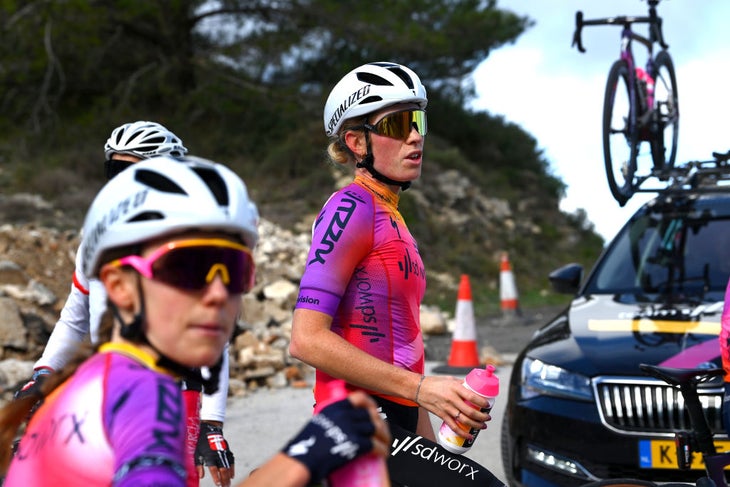
No one likes to bundle up and put in hard hours through the rain, cold, and wind. That’s what the northern classics are for.
By November, riders are coming off their prescribed off-season breaks, and few can face the harsh, brutal weather in home bases in Belgium, Denmark, or France.
“The weather is a factor, and that makes it easier to train, for sure,” said Lidl-Trek’s Toms Skuji?š, who hails from Latvia. “It’s usually cold everywhere in Europe in December. Here the weather is usually pretty nice. We put on a few layers, but it’s never super cold.”
Also read: Vollering relishing Alpe d’Huez stage
Team camps run from late November until just before the Christmas break. And while some riders and staffers head off to early season races like the Santos Tour Down Under, many reconvene again in January.
Winter is fully kicking into gear across Europe by then, but temperatures typically hover around the low to mid-60Fs across the sun belt in Spain. And it almost never rains.
Ideal for working up a pre-season sweat. That’s reason No. 1 why teams love Spain.
Calpe, Denia, Mallorca: Plenty of hotel rooms
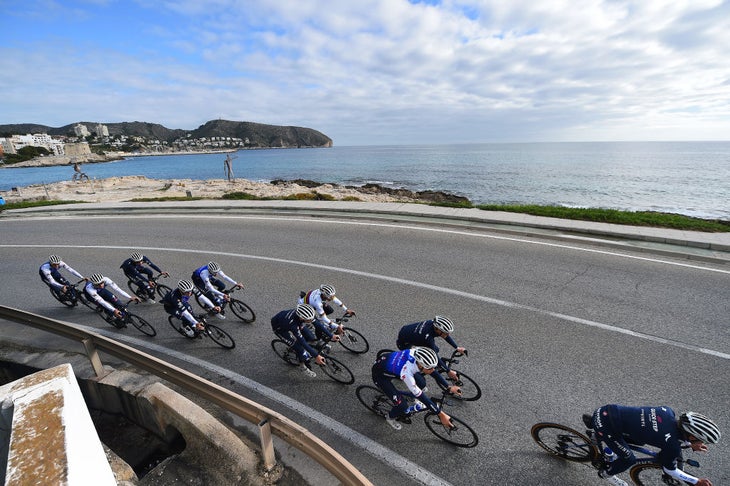
Another reason? Hotel rooms, and plenty of them.
It might not seem like such an important factor, but it is.
Teams can bring in more than 100 people for these important early season training camps, and there’s not many places in Europe that offer discount prices and great weather in the dark days of winter.
The Calpe area between Valencia and Alicante is a popular base for teams, with such dozens of squads as Lidl-Trek, DSM-firmenich PostNL, SD Worx, UAE Team Emirates, and Soudal Quick-Step packing riders, staffers, VIPs, and sponsors into dozens and dozens of hotel rooms.
“There are a lot of people here. There are more than 150 on contract with the team,” said Lidl-Trek’s Mads Pedersen, a burgeoning number that includes both the men’s and women’s WorldTour teams and staff. “It’s a big gathering when we are all together now.”
Location of training camps of 18 WorldTeams in December. ( Gazzetta) pic.twitter.com/mYgqpi5is8
— ammattipyöräily (@ammattipyoraily) November 23, 2022
Teams fill up hotels along the coast from Denia to Altea, and the hills above Alicante. Poga?ar’s UAE Team Emirates is perched above Benidorm at La Nucia, and Astana-Qazaqstan and Mark Cavendish are encamped at Altea.
Also read: Pedersen embraces change in classics quest
And many of the hotels also designed to accommodate cyclists, and large parking lots for team trucks to set up staging areas for training rides and bike fittings.
Teams return to the same hotels year after year.
Unlike the Teide volcano or other popular altitude training destinations that often are booked up years in advance, there are plenty of hotels sitting mostly vacant during the dormant winter months. Some that are closed down will sometimes reopen for a few weeks to accommodate returning teams.
Hotels offer deep discounts to the teams, which can book up to nearly 100 rooms at a time. That keeps staffers employed and busy all year round.
Endless ribbons of pavement: Ideal roads for training
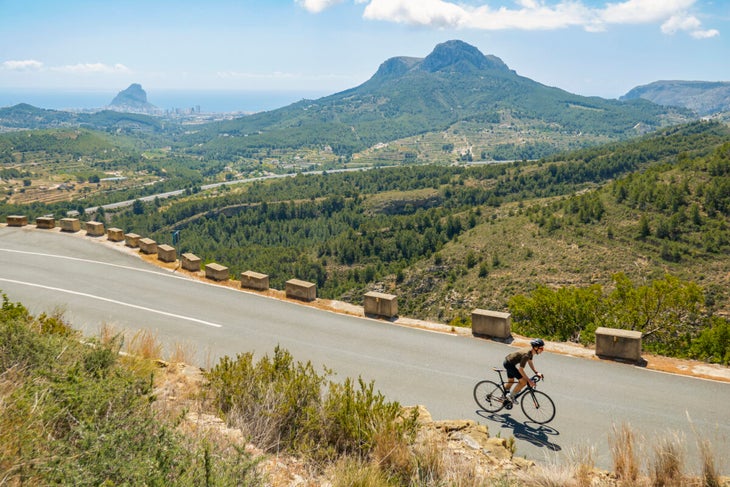
At first glance, vacation destination spots like Benidorm or Calpe evoke nightmarish visions of ugly front-line hotels and traffic-choked roads.
Head anywhere inland, however, and the Alicante region serves up ending miles of superb riding conditions on relatively low-traffic roads. Local drivers are used to seeing packs of spindly legged riders spinning around, and usually give way without too much drama.
“This area is perfect for training,” said UAE Team Emirates sport director Joxean Matxín Fernández. “Sometimes it can feel like a race, with so many teams and riders moving around on the roads.
“There is a bit of everything, some flats, so medium hills, and even a few mythic climbs,” he said. “It’s a perfect mix for what we need right now.”
Also read: Explainer: Why Poga?ar is taking on the Giro-Tour double now
Some teams used to train in southern Italy, but road conditions and access are considered better in Spain. Mechanics and staffers can drive down with team trucks and vehicles to the Spanish coast from team headquarters and service courses sprinkled across Europe with relative ease.
As Matxín said, there is a bit of something for everyone. There are flats along the coastal areas, especially north of Denia, and steeps if anyone wants to put in some climbing miles.
The legendary steeps of Coll de Rates are equidistant from Calpe and Denia, and the even steeper Xorret de Catí and Port de Tudons lurk within striking distance for a harder punch.
It can be congested and busy along the coastal strip, and accidents and crashes can happen. Chad Haga and John Degenkolb were among several riders injured in a horrible crash in 2016 when a driver turned directly into a group of riders from the then Giant-Alpecin team.
First touch with suffering: Laying the groundwork
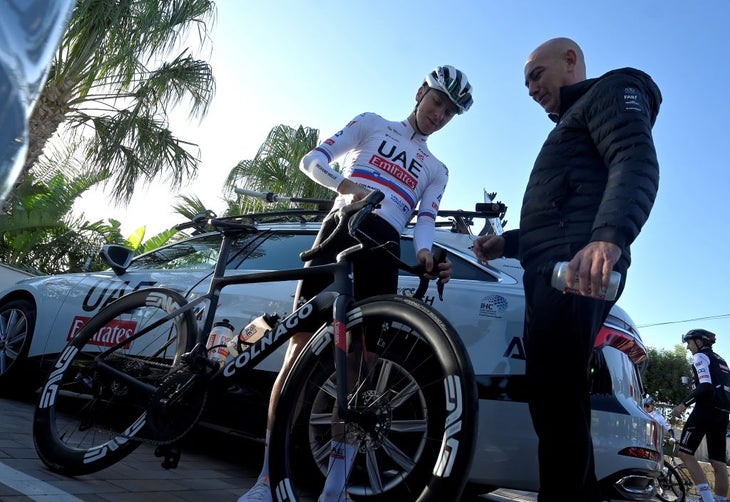
Riders typically head out in groups with differing levels of intensity.
The classics riders might already be upping the level, while riders heading to the grand tours will be on a slower keel.
December is all about building out the base.
“The roads are very good. It’s the best place to climb,” Declercq said. “This camp is always the first rise in volume, spiced up for some intensity, but not too much. We really turn up the intensity in the January camp, when we go to Denia. That’s when you start to really suffer.”
Also read: The best of Sepp Kuss and his historic Vuelta a España victory
The camps are also incredibly important in terms of testing out new gear, equipment, jerseys, and wheels.
Tadej Pogacar’s ‘MONSTROUS record time at Coll de Rates’ (@cyclingweekly) has been broken by Victor Campenaerts in training today (24’37min @ 5,99w/kg via Strava) – get ready for a belgian Tour de France winner. pic.twitter.com/xQghxgN2YB
— MF Naichaca (@NaichacaCycling) February 12, 2022
Mark Cavendish, who was a late-hour addition last year to Astana-Qazaqstan, said this year’s camp is in stark contrast to the rushed nature of what he went through at the end of 2022.
“It’s very different than last year,” Cavendish said from Altea. “It’s great weather here, and the training is really good here. I am very happy to going into the new season on top of everything with the bike and the team. It makes a difference.”
Cavendish and every one of his colleagues and rivals is hoping the seeds planted this winter will bloom into victories and success on the road once the racing clicks into gear. It all starts in Spain under the winter sun.
Meetings, planning, new teammates, new gear
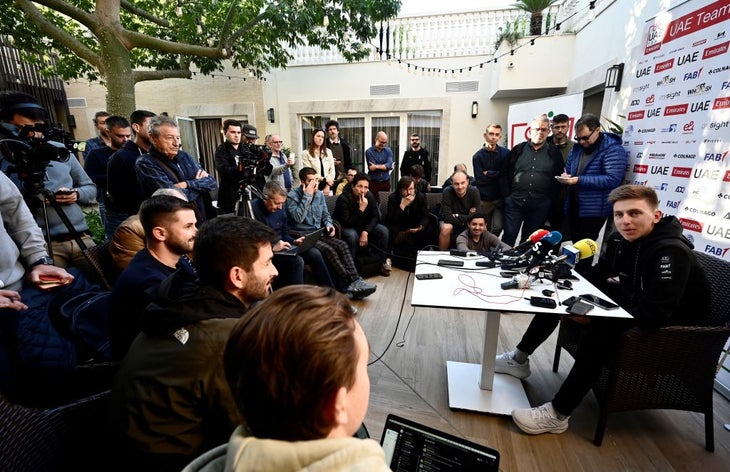
These pre-season camps also serve as a chance for new arrivals and staffers to link up with teammates.
Every winter is full of transfers, and some teams will have as many as a dozen new riders. Team camps are the first chance for everyone to get to know one another.
Poga?ar met with the media and dropped the bombshell that he’d be racing the Giro d’Italia for the first time.
Also read: Geoghegan Hart and his Tour de France quest
And incredibly enough, these winter camps, especially the ones in December, are the only chance when nearly everyone across the sprawling infrastructure of mechanics, staffers, sport directors, managers, nutritionists, coaches, and riders are all under one roof at one time.
“I never really had a chance to say goodbye to everyone,” said Tao Geoghegan Hart, who left Ineos Grenadiers to join Lidl-Trek. “Once the season starts, you don’t see some of your teammates for months. I might not see some of these people now until months later. The camps are really the only chance to be together with everyone at the same time.”
The racing season starts soon enough. By then, the nomadic lifestyle of a professional racing kicks into high gear.
View this post on Instagram
What's your reaction ?
Follow us on Social Media
Some Categories
Recent posts

July 27, 2024
Nieuwe kabinetsvisie: samen sterker tegen cyberdreigingen

July 24, 2024
Navigating AI Implementation: Try these strategies to overcome resistance.

July 24, 2024
Sick Leave Policy Netherlands Guidance for HR and Entrepreneur.

July 24, 2024
CSRD Reporting: Mandatory Reporting on Corporate Sustainability.

July 24, 2024
Training Budget: Investing in Employee Development.

 Inloggen
Inloggen
 Registreren
Registreren






Comments (0)
No reviews found
Add Comment